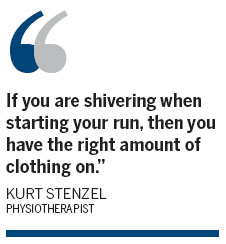Winter no excuse for not jogging
Dressing appropriately and not jogging too fast is recommended when running in cold weather, but a proper warm-up routine is the best preparation for training in winter.
Joggers shouldn't be put off by gray skies, cold temperatures and, even, some rain or snow if they want to retain their fitness and form through the winter months, especially as it is possible to run in most weather conditions.
When training, it's important to take note of what clothing to wear.
"With the proper clothing, jogging in winter really shouldn't be a problem," says ultra-marathon runner Birgit Lennartz.
Correct clothing ensures sweat is transported away from the skin so the jogger doesn't suffer from shivering or cools down.
The use of clothing made out of different materials isn't a problem, but if a jogger starts running slowly at the end of their route or even stops for a brief period then sweat-soaked woolen shirts will cling to the body and this will increase the risk of a cold enormously.
One mistake common to beginners and experienced joggers alike is wearing too much when running in winter.
However, it often becomes clear after running just a couple of hundred meters that less clothing than imagined is generally the right decision. A jogger who begins their run wearing too much clothing will end up sweating too much, raising the risk of a chill.
"If you are shivering when starting your run, then you have the right amount of clothing on," explains physiotherapist Kurt Stenzel.
The so-called "onion principle" is a tried and tested way of keeping warm and involves the use of layering for the upper body. A good suggestion is to wear an under vest and T-shirt below a long-armed shirt and, if necessary, a windproof jacket.

"When it is windy, the temperature feels colder than it is in reality," Stenzel explains.
Loose leggings made of warm material should be worn. A hat and gloves are also important.
"Otherwise a person can cool down very quickly, making them more sensitive to viruses and bacterial infection," explains Martin Engelhardt, an orthopedist and winner of several Ironman races.
The gloves can always be taken off and stuffed in a pocket if it gets too warm during the jog. The hat, or at least a headband, should remain on the head as the body loses a large part of its warmth from this area.
A scarf may also be necessary, depending on how sensitive the respiratory tract feels. Some joggers feel pain when cold air hits their bronchi, something that can be prevented by a scarf or shawl.
"The general rule is that it should be worn as far away from the body as possible," Stenzel says. It also makes sense to breathe through your nose.
Most importantly, the body's muscles have to warm up slowly and well in winter. "You can walk for 10 minutes or jog slowly to bring your muscles up to the right temperature," Engelhardt says.
Running fast is taboo in the cold winter months, when basic training should instead be on the agenda.
There should be no differences in the length of time spent jogging between winter and summer. It is possible to run for half-an-hour or, when conditions permit, for up to three hours.
Obviously, it's not recommended to run in icy conditions although snow is less of a problem, even though it is more energy sapping and more of a burden on the body than running on asphalt or on firm ground.
German Press Agency
(China Daily 01/12/2011 page19)


















